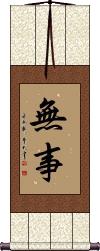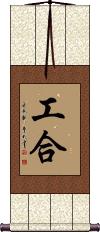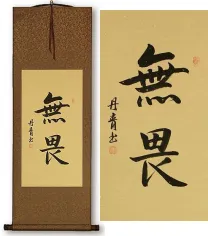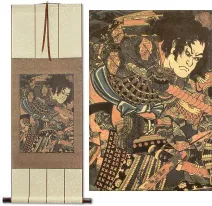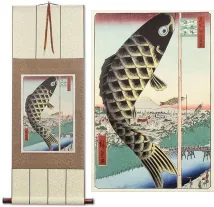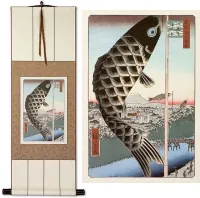Many custom options...
And formats...

Not what you want?
Try other similar-meaning words, fewer words, or just one word.
No End in Chinese / Japanese...
Buy a No End calligraphy wall scroll here!
Personalize your custom “No End” project by clicking the button next to your favorite “No End” title below...
1. No Trouble / Freedom from Problems
2. Undaunted After Repeated Setbacks
4. Wisteria
5. There is one single thread binding my Way together
6. Gung Ho
7. Tiger Rumor
No Trouble / Freedom from Problems
無事 is a Zen Buddhist term meaning no problem and no trouble.
無事 is the Zen state of perfect freedom from troubles and leaving secular affairs behind.
Sometimes this is used to describe the state of satori and complete tranquility of mind.
Written as 無事に with an extra Hiragana at the end, this becomes an adverb to describe something in the condition of safety, peace, quietness, and without troubles.
無事 (Buji) can also be a given name in Japan.
This has more meaning in the Japanese Zen Buddhist community than in China or Korea, where it can mean “be free” or “nothing to do or worry about.”
Undaunted After Repeated Setbacks
Persistence to overcome all challenges
百折不撓 is a Chinese proverb that means “Be undaunted in the face of repeated setbacks.”
More directly translated, it reads, “[Overcome] a hundred setbacks, without flinching.” 百折不撓 is of Chinese origin but is commonly used in Japanese and somewhat in Korean (same characters, different pronunciation).
This proverb comes from a long, and occasionally tragic story of a man that lived sometime around 25-220 AD. His name was Qiao Xuan, and he never stooped to flattery but remained an upright person at all times. He fought to expose the corruption of higher-level government officials at great risk to himself.
Then when he was at a higher level in the Imperial Court, bandits were regularly capturing hostages and demanding ransoms. But when his own son was captured, he was so focused on his duty to the Emperor and the common good that he sent a platoon of soldiers to raid the bandits' hideout, and stop them once and for all even at the risk of his own son's life. While all of the bandits were arrested in the raid, they killed Qiao Xuan's son at first sight of the raiding soldiers.
Near the end of his career, a new Emperor came to power, and Qiao Xuan reported to him that one of his ministers was bullying the people and extorting money from them. The new Emperor refused to listen to Qiao Xuan and even promoted the corrupt Minister. Qiao Xuan was so disgusted that in protest, he resigned from his post as minister (something almost never done) and left for his home village.
His tombstone reads “Bai Zhe Bu Nao” which is now a proverb used in Chinese culture to describe a person of strong will who puts up stubborn resistance against great odds.
My Chinese-English dictionary defines these 4 characters as “keep on fighting despite all setbacks,” “be undaunted by repeated setbacks,” and “be indomitable.”
Our translator says it can mean “never give up” in modern Chinese.
Although the first two characters are translated correctly as “repeated setbacks,” the literal meaning is “100 setbacks” or “a rope that breaks 100 times.” The last two characters can mean “do not yield” or “do not give up.”
Most Chinese, Japanese, and Korean people will not take this absolutely literal meaning but will instead understand it as the title suggests above. If you want a single big word definition, it would be indefatigability, indomitableness, persistence, or unyielding.
See Also: Tenacity | Fortitude | Strength | Perseverance | Persistence
Learning is Eternal
This Chinese philosophy tells of how we continue to learn throughout our lives.
This proverb can be translated in a few ways such as “Study has no end,” “Knowledge is infinite,” “No end to learning,” “There's always something new to study,” or “You live and learn.”
The deeper meaning: Even when we finish school we are still students of the world gaining more knowledge from our surroundings with each passing day.
See Also: An Open Book Benefits Your Mind | Wisdom | Learn From Wisdom
Wisteria
藤 is the Japanese Kanji for wisteria (especially Japanese wisteria, Wisteria floribunda).
藤 is also written with a longer title, 藤の花 (fuji no hana), which just adds “flower of” to the end.
藤 is really only applicable in Japanese, as it means the following in Chinese: Creepers, cane; canes; rattan; vine.
There is one single thread binding my Way together
吾道一以貫之 is a phrase from the Analects of Confucius that translates as “My Way has one thread that runs through it.”
Other translations include:
My Way is penetrated by a single thread.
There is one single thread binding my Way together.
My Way is run through with a unifying thread.
My Way is Consistent.
And sometimes poetic license is taken, and it is translated as:
My Way is the only one; I'll treasure it and stick to it with humility until the end.
After this was said, some 2500+ years ago, another disciple of Confucius clarified the meaning by stating, “Our master's Way is to be loyal and have a sense of reciprocity.”
In Japanese, this is purported to be romanized as “Waga michi ichi wo motte kore wo tsuranuku,” though some will argue the true pronunciation.
Note: Sometimes written 吾道以一貫之 instead of 吾道一以貫之 with no difference in meaning.
Gung Ho
Working Together
工合 is one of those Asian words that is used more in English than in the original Chinese.
Gung Ho was originally used to speak of Carlson's Raiders, a group of “Gung Ho” U.S. Marines who went on an island-hopping campaign of death during WWII.
A movie called Gung Ho came out in the mid-1940s and was later re-released in the 1950s depicting the 2nd Marine Raider Battalion, and brought this word to the mainstream.
It is still sometimes used today within the U.S. Marine Corps brotherhood to refer to a unit or group that works well together or is otherwise efficient and motivated (has good morals).
In 1986, there was a movie called Gung Ho about a Japanese company taking over an American automotive factory. They completely ignored the fact that this was a Chinese title.
It should be noted that this title actually means a condition, state, manner, or the health of something in Japanese.
Language and pronunciation notes:
Like many Asian words absorbed into common use in English, this one is drastically mispronounced. The official Romanization is “gong he” but that doesn't tell you enough. The vowel sound on the first character is like the English word “own,” now just add the g-sounds to the beginning and end. The second character is misleading, as you might think it is like the English word “he.” In reality, the vowel sound is more like the “u” in “up.”
It should also be noted that the current generation in China no longer uses or recognizes this as a common word or slogan.
Note: This can be pronounced and is a word in Japanese, though seldom used. Japanese will use a variation of "具合" instead. But still, not common.
Tiger Rumor
These four characters together relay the meaning that can be expressed in English as “When three people say there's a tiger running in the street, you believe it.”
Of course, there is an ancient story behind this idiom...
三人成虎 is actually a proverb that resulted from a conversation that occurred around 300 B.C.
The conversation was between the king of the Wei kingdom and one of the king's ministers named Pang Cong.
It was near the end of one of many wars, this time with the Zhao kingdom. Pang Cong was to be sent by the king to the Zhao kingdom with the king's son, who was to be held hostage. It was common at the time for a king to make his son a hostage to secure stable peace between warring kingdoms.
Before minister Pang Cong departed, he asked his king, “If one person told you a tiger was running in the street, would you believe it?.”
“No,” the king said.
The minister continued, “What if two people told you?”
The king replied, “Well, I would have my doubts but I might believe it.”
The minister continued, “So, what if three people told you that a tiger is running in the streets?”
The king replied, “Yes, I would believe it. It must be true if three people say it.”
The minister then reminded the king, “Your son and I are now traveling far away to live in the distant Zhao kingdom - much farther from your palace than the street. Rumors may fly about me in my absence, so I hope your majesty will weight such rumors appropriately.”
The king replied, “I have every trust in you, do not worry”
While the minister was gone, the king's enemies gossiped about minister Pang Cong on many occasions. At first, the king thought nothing of these comments and rumors. But slowly, as the rumors mounted, the king began to suspect ill of his minister.
Sometime later, when peace was well-established, the minister and prince were freed and returned to the kingdom of Wei. The king received his son BUT DID NOT EVEN SUMMON MINISTER PANG CONG TO THE PALACE!
Hopefully, this story will help you see how dangerous words can be when used to promote rumors or create ill will. And perhaps will inspire you not to believe everything you hear.
There is also a secondary suggestion in this idiom that gossip is as ferocious as a tiger. Some Chinese people who don't know the ancient story above may believe that this scroll means that rumors are as vicious as three tigers.
Note: This proverb appears in my Korean dictionary but is not well-known in Korea.
This in-stock artwork might be what you are looking for, and ships right away...
Gallery Price: $108.00
Your Price: $59.88
Gallery Price: $108.00
Your Price: $59.88
Gallery Price: $61.00
Your Price: $33.88
Gallery Price: $61.00
Your Price: $33.88
Gallery Price: $61.00
Your Price: $33.88
Gallery Price: $61.00
Your Price: $33.88
Gallery Price: $61.00
Your Price: $33.88
Gallery Price: $61.00
Your Price: $33.88
Gallery Price: $61.00
Your Price: $33.88
Gallery Price: $61.00
Your Price: $33.88
Gallery Price: $61.00
Your Price: $33.88
Gallery Price: $108.00
Your Price: $59.88
Gallery Price: $90.00
Your Price: $49.88
Not the results for no end that you were looking for?
Below are some entries from our dictionary that may match your no end search...
| Characters If shown, 2nd row is Simp. Chinese |
Pronunciation Romanization |
Simple Dictionary Definition |
ウマ see styles |
uma ウマ |
More info & calligraphy: Uma |
けり see styles |
keri けり |
More info & calligraphy: Keru |
修行 see styles |
xiū xíng xiu1 xing2 hsiu hsing shugyou(p); sugyou(ok) / shugyo(p); sugyo(ok) しゅぎょう(P); すぎょう(ok) |
More info & calligraphy: Shugyo(noun, transitive verb) (1) training; practice; discipline; study; (noun, transitive verb) (2) {Buddh} ascetic practices; (personal name) Nobuyuki caryā, conduct; to observe and do; to end one's ways; to cultivate oneself in right practice; be religious, or pious. |
劉備 刘备 see styles |
liú bèi liu2 bei4 liu pei ryuubi / ryubi りゅうび |
More info & calligraphy: Liu Bei(person) Liu Bei (161-223) |
合掌 see styles |
hé zhǎng he2 zhang3 ho chang gasshou / gassho がっしょう |
More info & calligraphy: Gassho(n,vs,vi) (1) pressing one's hands together in prayer; (2) triangular frame of a thatched roof; (expression) (3) (at the end of Buddhist correspondence) (See 敬具) yours sincerely; yours truly; sincerely yours; (surname) Gasshou the gesture of joining one's palms and putting them to the breast as an expression of reverence |
四諦 四谛 see styles |
sì dì si4 di4 ssu ti shitai したい |
More info & calligraphy: Four Noble Truths (Buddhism){Buddh} (See 苦集滅道) The Four Noble Truths catvāri-ārya-satyāni; 四聖諦; 四眞諦. The four dogmas, or noble truths, the primary and fundamental doctrines of Śākyamuni, said to approximate to the form of medical diagnosis. They are pain or 'suffering, its cause, its ending, the way thereto; that existence is suffering, that human passion (taṇhā, 欲 desire) is the cause of continued suffering, that by the destruction of human passion existence may be brought to an end; that by a life of holiness the destruction of human passion may be attained'. Childers. The four are 苦, 聚 (or 集), 滅, and 道諦, i. e. duḥkha 豆佉, samudaya 三牟提耶, nirodha 尼棲陀, and mārga 末加. Eitel interprets them (1) 'that 'misery' is a necessary attribute of sentient existence'; (2) that 'the 'accumulation' of misery is caused by the passions'; (3) that 'the 'extinction' of passion is possible; (4) mārga is 'the doctrine of the 'path' that leads to the extinction of passion'. (1) 苦 suffering is the lot of the 六趣 six states of existence; (2) 集 is the aggregation (or exacerbation) of suffering by reason of the passions; (3) 滅 is nirvana, the extinction of desire and its consequences, and the leaving of the sufferings of mortality as void and extinct; (4) 道 is the way of such extinction, i. e. the 八正道 eightfold correct way. The first two are considered to be related to this life, the last two to 出世間 a life outside or apart from the world. The four are described as the fundamental doctrines first preached to his five former ascetic companions. Those who accepted these truths were in the stage of śrāvaka. There is much dispute as to the meaning of 滅 'extinction' as to whether it means extinction of suffering, of passion, or of existence. The Nirvana Sutra 18 says that whoever accepts the four dogmas will put an end to births and deaths 若能見四諦則得斷生死 which does not of necessity mean the termination of existence but that of continued transmigration. v. 滅. |
華佗 华佗 see styles |
huà tuó hua4 tuo2 hua t`o hua to kada かだ |
More info & calligraphy: Hua Tuo(personal name) Kada |
エンド see styles |
endo エンド |
More info & calligraphy: Endu |
奢摩他 see styles |
shē mó tā she1 mo2 ta1 she mo t`a she mo ta shamata |
More info & calligraphy: Samatha |
ハリソン see styles |
parison パリソン |
More info & calligraphy: Harrison |
學無止境 学无止境 see styles |
xué wú zhǐ jìng xue2 wu2 zhi3 jing4 hsüeh wu chih ching |
More info & calligraphy: Learning is Eternal |
戦い抜く see styles |
tatakainuku たたかいぬく |
More info & calligraphy: Fight to the End / Fight Until the Bitter End |
え see styles |
e え |
(interjection) (1) eh?; what?; oh?; (interjection) (2) (See はい・1) yes; that's correct; (particle) (3) (archaism) (at sentence end) (See かえ,ぞえ,わえ) strengthens a question, assertion, etc.; (particle) (4) (archaism) (after a noun, etc.; when calling out to someone) hey |
か see styles |
ka か |
(particle) (1) (at sentence end) indicates a question; (particle) (2) (after each alternative) or; whether or not; (particle) (3) (after an interrogative) (See 何か・1) some- (e.g. something, someone); (particle) (4) (indicates doubt, uncertainty, etc.; sometimes after other particles) hmm; huh; (prefix) (5) (emphatic prefix; usu. before an adjective) (See か弱い) very; (suffix) (6) (suffix forming adjectives or adverbs; after an indeclinable word) (See 定か) -al; -ial; -ic; -ical; -ish; -y; (adverb) (7) (archaism) in that way |
さ see styles |
sa さ |
(suffix) (1) (nominalizing suffix indicating degree or condition) -ness; (particle) (2) (sentence end, mainly masc.) indicates assertion; (interjection) (3) (See さあ・1) come; come now; (personal name) Zsa |
な see styles |
na な |
(particle) (1) (prohibitive; used with dictionary form verb) don't; (particle) (2) (imperative (from なさい); used with -masu stem of verb) do; (interjection) (3) (See なあ) hey; listen; you; (particle) (4) (when seeking confirmation, for emphasis, etc.; used at sentence end) now, ...; well, ...; I tell you!; you know; (particle) (5) (used to express admiration, emotionality, etc.; used at sentence end) wow; ooh |
の see styles |
no の |
(particle) (1) (occasionally ん, orig. written 乃 or 之) (See 乃) indicates possessive; (particle) (2) nominalizes verbs and adjectives; (particle) (3) (See が・1) substitutes for "ga" in subordinate phrases; (particle) (4) (often ん) (at sentence-end, falling tone) indicates a confident conclusion; (particle) (5) (feminine speech) (at sentence-end) indicates emotional emphasis; (particle) (6) (at sentence-end, rising tone) indicates question |
わ see styles |
wa わ |
(particle) (1) (feminine speech) (at sentence end) indicates emotion or admiration; (particle) (2) (ksb:) (at sentence end) indicates emphasis; (pronoun) (3) (tsug:) I; me; (interjection) (4) wah!; (interjection) (5) boo!; (female given name) Wa |
下 see styles |
xià xia4 hsia shimo しも |
down; downwards; below; lower; later; next (week etc); second (of two parts); to decline; to go down; to arrive at (a decision, conclusion etc); measure word to show the frequency of an action (1) (ant: 上・かみ・1) lower reaches (of a river); (2) bottom; lower part; (3) lower half (of the body, esp. the privates); feces (faeces); urine; menses; (4) end; far from the imperial palace (i.e. far from Kyoto, esp. of western Japan); (can be adjective with の) (5) dirty (e.g. dirty jokes, etc.); (place-name, surname) Shimo hīna, adhara. Below, lower, inferior, low; to descend, let down, put down. |
丘 see styles |
qiū qiu1 ch`iu chiu tsukasa つかさ |
mound; hillock; grave; classifier for fields (archaism) mound; hill; (1) hill; height; knoll; rising ground; (2) (mahj) (kana only) bonus points awarded to the winner at the end of a game; (female given name) Tsukasa A mound, a plot; personal name of Confucius. |
乍 see styles |
zhà zha4 cha nagara ながら |
at first; suddenly; abruptly; to spread; (of hair) to stand on end; bristling (surname) Nagara |
了 see styles |
liǎo liao3 liao ryou / ryo りょう |
to finish; to achieve; variant of 瞭|了[liao3]; to understand clearly finish; completion; the end; (personal name) Riyou To end, see through, understand, thoroughly, know, make clear, thoroughly, completely, final. |
儩 see styles |
sì si4 ssu |
the end; to finish |
吹 see styles |
chuī chui1 ch`ui chui fuki ふき |
to blow; to play a wind instrument; to blast; to puff; to boast; to brag; to end in failure; to fall through (surname) Fuki To blow; puff, praise. |
嚢 see styles |
yuzuru ゆずる |
(1) bag; sack; pouch; (2) skin of an orange (and other like fruits); (3) dead end; (4) plot of land surrounded by water; (personal name) Yuzuru |
央 see styles |
yāng yang1 yang ou / o おう |
center; end; to beg; to plead (suffix) middle; centre; center; (female given name) Manaka The middle, medial: to solicit; ample, vast. |
委 see styles |
wěi wei3 wei i い |
to entrust; to cast aside; to shift (blame etc); to accumulate; roundabout; winding; dejected; listless; committee member; council; end; actually; certainly (suffix noun) (abbreviation) (See 委員会) committee; commission; board; panel; (female given name) Tomo To throw down, depute; really; crooked; the end. |
完 see styles |
wán wan2 wan kan かん |
to finish; to be over; whole; complete; entire (expression) (1) (at the end of a novel, film, etc.) The End; Finis; (suffix noun) (2) completion; conclusion; end; (suffix noun) (3) full provision; (given name) Yutaka to perfect |
宛 see styles |
wǎn wan3 wan ango あんご |
winding; as if (1) aim; object; purpose; end; (2) expectations; prospects; hopes; (3) something that can be relied upon; (4) (ksb:) snack served with alcoholic drink; (suffix noun) (5) pad; guard; (n-suf,n-pref) (6) blow; strike; (suffix) (7) addressed to; (8) (kana only) per; (personal name) Ango completely |
尻 see styles |
kāo kao1 k`ao kao shiri しり ketsu けつ |
(literary) buttocks; rump; coccyx; sacrum (1) buttocks; behind; rump; bottom; (2) undersurface; bottom; (3) last place; end; (4) consequence; (1) (colloquialism) ass; arse; buttocks; (2) (colloquialism) rear; end |
Click here for more no end results from our dictionary
The following table may be helpful for those studying Chinese or Japanese...
| Title | Characters | Romaji (Romanized Japanese) | Various forms of Romanized Chinese | |
| No Trouble Freedom from Problems | 無事 无事 | buji | wú shì / wu2 shi4 / wu shi / wushi | wu shih / wushih |
| Undaunted After Repeated Setbacks | 百折不撓 百折不挠 | hyaku setsu su tou hyakusetsusutou hyaku setsu su to | bǎi zhé bù náo bai3 zhe2 bu4 nao2 bai zhe bu nao baizhebunao | pai che pu nao paichepunao |
| Learning is Eternal | 學無止境 学无止境 | xué wú zhǐ jìng xue2 wu2 zhi3 jing4 xue wu zhi jing xuewuzhijing | hsüeh wu chih ching hsüehwuchihching |
|
| Wisteria | 藤 | fuji | téng / teng2 / teng | t`eng / teng |
| There is one single thread binding my Way together | 吾道一以貫之 吾道一以贯之 | ware dou tsurayuki waredoutsurayuki ware do tsurayuki | wú dào yī yǐ guàn zhī wu2 dao4 yi1 yi3 guan4 zhi1 wu dao yi yi guan zhi wudaoyiyiguanzhi | wu tao i i kuan chih wutaoiikuanchih |
| Gung Ho | 工合 | guai | gōng hé / gong1 he2 / gong he / gonghe | kung ho / kungho |
| Tiger Rumor | 三人成虎 | sān rén chéng hǔ san1 ren2 cheng2 hu3 san ren cheng hu sanrenchenghu | san jen ch`eng hu sanjenchenghu san jen cheng hu |
|
| In some entries above you will see that characters have different versions above and below a line. In these cases, the characters above the line are Traditional Chinese, while the ones below are Simplified Chinese. | ||||
Successful Chinese Character and Japanese Kanji calligraphy searches within the last few hours...
